Impact of tumor vascularity on responsiveness to antiangiogenesis in a prostate cancer stem cell-derived tumor model
- PMID: 23635653
- PMCID: PMC3816513
- DOI: 10.1158/1535-7163.MCT-12-1240
Impact of tumor vascularity on responsiveness to antiangiogenesis in a prostate cancer stem cell-derived tumor model
Abstract
Drugs that target the tumor vasculature and inhibit angiogenesis are widely used for cancer treatment. Individual tumors show large differences in vascularity, but it is uncertain how these differences affect responsiveness to antiangiogenesis. We investigated this question using two closely related prostate cancer models that differ markedly in tumor vascularity: PC3, which has very low vascularity, and the PC3-derived cancer stem-like cell holoclone PC3/2G7, which forms tumors with high microvessel density, high tumor blood flow, and low hypoxia compared with parental PC3 tumors. Three angiogenesis inhibitors (axitinib, sorafenib, and DC101) all induced significantly greater decreases in tumor blood flow and microvessel density in PC3/2G7 tumors compared with PC3 tumors, as well as significantly greater decreases in tumor cell proliferation and cell viability and a greater increase in apoptosis. The increased sensitivity of PC3/2G7 tumors to antiangiogenesis indicates they are less tolerant of low vascularity and suggests they become addicted to their oxygen- and nutrient-rich environment. PC3/2G7 tumors showed strong upregulation of the proangiogenic factors chemokine ligand 2 (CCL2) and VEGFA compared with PC3 tumors, which may contribute to their increased vascularity, and they have significantly lower endothelial cell pericyte coverage, which may contribute to their greater sensitivity to antiangiogenesis. Interestingly, high levels of VEGF receptor-2 were expressed on PC3 but not PC3/2G7 tumor cells, which may contribute to the growth static response of PC3 tumors to VEGF-targeted antiangiogenesis. Finally, prolonged antiangiogenic treatment led to resumption of PC3/2G7 tumor growth and neovascularization, indicating these cancer stem-like cell-derived tumors can adapt and escape from antiangiogenesis.
©2013 AACR
Conflict of interest statement
Figures

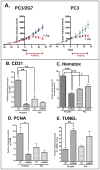

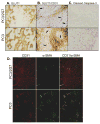
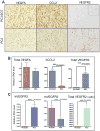
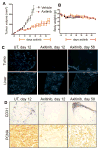
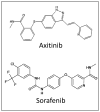
Similar articles
-
Nonclinical antiangiogenesis and antitumor activities of axitinib (AG-013736), an oral, potent, and selective inhibitor of vascular endothelial growth factor receptor tyrosine kinases 1, 2, 3.Clin Cancer Res. 2008 Nov 15;14(22):7272-83. doi: 10.1158/1078-0432.CCR-08-0652. Clin Cancer Res. 2008. PMID: 19010843
-
CXCR2 Inhibition Combined with Sorafenib Improved Antitumor and Antiangiogenic Response in Preclinical Models of Ovarian Cancer.PLoS One. 2015 Sep 28;10(9):e0139237. doi: 10.1371/journal.pone.0139237. eCollection 2015. PLoS One. 2015. PMID: 26414070 Free PMC article.
-
Differential sensitivity of prostate tumor derived endothelial cells to sorafenib and sunitinib.BMC Cancer. 2014 Dec 12;14:939. doi: 10.1186/1471-2407-14-939. BMC Cancer. 2014. PMID: 25494980 Free PMC article.
-
[Possibilities for inhibiting tumor-induced angiogenesis: results with multi-target tyrosine kinase inhibitors].Magy Onkol. 2012 Mar;56(1):3-15. Epub 2012 Jan 3. Magy Onkol. 2012. PMID: 22403757 Review. Hungarian.
-
The role of antiangiogenesis therapy: bevacizumab and beyond.Clin Transl Oncol. 2009 Jun;11(6):349-55. doi: 10.1007/s12094-009-0368-0. Clin Transl Oncol. 2009. PMID: 19531449 Review.
Cited by
-
The osteoblastic and osteoclastic interactions in spinal metastases secondary to prostate cancer.Cancer Growth Metastasis. 2013 Nov 27;6:61-80. doi: 10.4137/CGM.S12769. eCollection 2013. Cancer Growth Metastasis. 2013. PMID: 24665208 Free PMC article. Review.
-
H460 non-small cell lung cancer stem-like holoclones yield tumors with increased vascularity.Cancer Lett. 2014 Apr 28;346(1):63-73. doi: 10.1016/j.canlet.2013.12.012. Epub 2013 Dec 12. Cancer Lett. 2014. PMID: 24334139 Free PMC article.
-
A phase II evaluation of cediranib in the treatment of recurrent or persistent endometrial cancer: An NRG Oncology/Gynecologic Oncology Group study.Gynecol Oncol. 2015 Sep;138(3):507-12. doi: 10.1016/j.ygyno.2015.07.018. Epub 2015 Jul 15. Gynecol Oncol. 2015. PMID: 26186911 Free PMC article. Clinical Trial.
-
The role of endothelial cell-pericyte interactions in vascularization and diseases.J Adv Res. 2025 Jan;67:269-288. doi: 10.1016/j.jare.2024.01.016. Epub 2024 Jan 20. J Adv Res. 2025. PMID: 38246244 Free PMC article. Review.
-
Multi-modal characterization of vasculature and nanoparticle accumulation in five tumor xenograft models.J Control Release. 2018 Jun 10;279:292-305. doi: 10.1016/j.jconrel.2018.04.026. Epub 2018 Apr 21. J Control Release. 2018. PMID: 29684498 Free PMC article.
References
-
- Johannessen TC, Wagner M, Straume O, Bjerkvig R, Eikesdal HP. Tumor vasculature: the Achilles’ heel of cancer? Expert Opin Ther Targets. 2013;17:7–20. - PubMed
-
- Tang C, Ang BT, Pervaiz S. Cancer stem cell: target for anti-cancer therapy. FASEB J. 2007;21:3777–85. - PubMed
-
- Hanahan D, Folkman J. Patterns and emerging mechanisms of the angiogenic switch during tumorigenesis. Cell. 1996;86:353–64. - PubMed
-
- Tie J, Desai J. Antiangiogenic therapies targeting the vascular endothelia growth factor signaling system. Crit Rev Oncog. 2012;17:51–67. - PubMed
Publication types
MeSH terms
Substances
Grants and funding
LinkOut - more resources
Full Text Sources
Other Literature Sources
Medical

